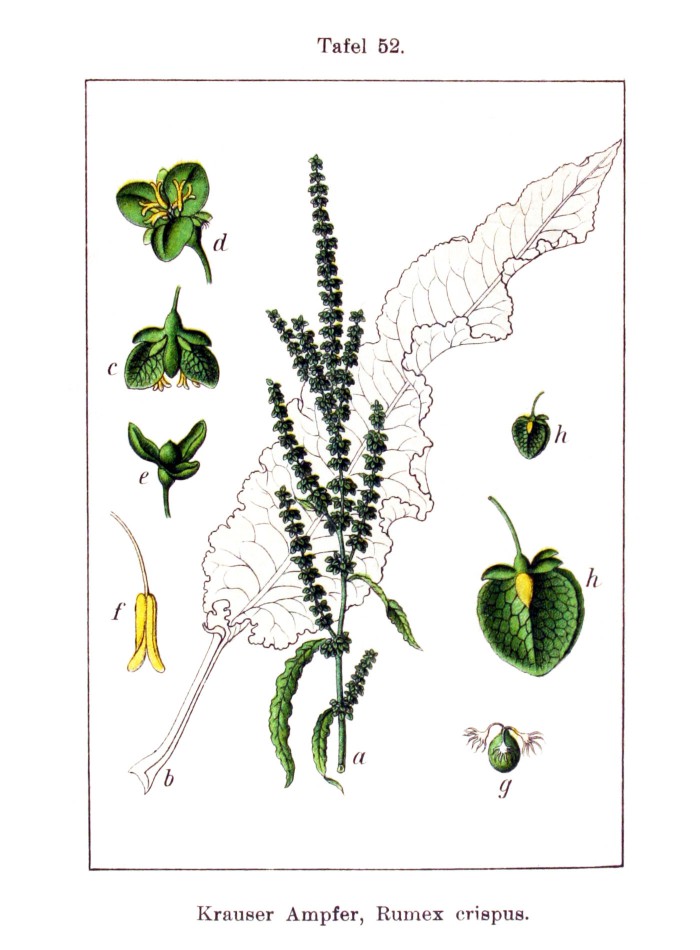Rumex crispus L. - Polygonaceae - yellow dock, curled dock, curly dock, Krauser Ampfer
Perennial herb, up to 1m high, widely native or naturalized; leaves lanceolate to lanceolate-linear, base cuneate, truncate, or weakly cordate, margins strongly crisped and undulate; flowers 10-25 in whorls, greenish; achenes usually reddish brown. „Rumex crispus hybridizes with many other species of subg. Rumex. Hybrids with R. obtusifolius (Rumex ×pratensis Mertens & Koch) are the most common in the genus, at least in Europe, and have been reported for several localities in North America.“ http://www.efloras.org/florataxon.aspx?flora_id=1&taxon_id=200006746
„It can be used as a wild leaf vegetable; the young leaves should be boiled in several changes of water to remove as much of the oxalic acid in the leaves as possible or can be added directly to salads in moderate amounts.“ wikipedia
The Rumex species belong to the emodin drugs that cause mild laxation due to stimulation of the colon activity.
[Lehrbuch der Biologischen Heilmittel, Gerhard Madaus, 1938] http://henriettes-herb.com/eclectic/madaus/rumex.html
„Anthraquinone glycoside amount of R.crispus has given for underground part 0.52% and for aerial part 0.44% (Sener et al., 1987)… The highest anthraquinone glycoside content was established in the roots of R.crispus during vegetation stages (0.35-0.91%) while the stem from 0.03-0.46%, leaves 0.05-0.40% and the fruits 0.08-0.34% reached. It is evident from the data, that all parts of plant showed the highest anthraquinone glycoside content in August… Rumex crispus contained not only emodin, chrysophanol and physcion glycoside but also aloe-emodin glycoside.“
[Concentrations of anthraquinone glycosides of Rumex crispus during different vegetation stages., Demirezer, L.Ö., Zeitschrift für Naturforschung C, 49(7-8), 1994, 404-406] http://www.degruyter.com/downloadpdf/j/znc.1994.49.issue-7-8/znc-1994-7-802/znc-1994-7-802.xml
Of ten species of wild edible plants, highest oxalic acid content has been found in Chenopodium album (1100 mg/100 g), Amaranthus viridis (960 mg/100 g), and Rumex crispus (620 mg/100 g).
„The toxicity threshold of oxalic acid is quite low; minimal lethal dose for humans is considered to be ca.5 g for an adult… curly dock (Rumex crispusL.), caused fatal poisoning due to ingestion of the plant material. Among the pathological findings were centrolobular hepatic necrosis and birefringent crystals in the liver and kidneys (Panciera et al., 1990; Reig et al., 1991)… From a strictly nutritional point of view, the main problem which arises is the bioavailability of calcium in the alimentary ration. This bioavailability is determined by the ratio (oxalic acid g/kg)/(calcium g/kg). Some nourishments have high ratios: rhubarb (25.0), spinach (10.0), potato (5.0), cocoa (6.7), and tea (2.6) (Derache, 1990). Nourishments with ratios higher than 2.5 are poor calcium sources and also can be considered as decalcifiers… curly dock (32.0)… could have the highest adverse impact on dietary calcium bioavailability due to the value of the ratio oxalic acid/calcium, although it is not the one with the highest value of oxalic acid.“
[Oxalic acid and calcium determination in wild edible plants., Guil, J.L., Torija, M.E., Giménez, J.J., Rodríguez-García, I., Giménez, A., Journal of Agricultural and Food Chemistry, 44(7), 1996, 1821-1823]
The sliced and dried roots are traditionally used (infusion or decoction) as laxative to treat constipation, liver problems and arthritis, internal parasites (tapeworm, roundworm), chronic skin problems, vascular disorders and internal bleeding. Externally applied to ulcers, boils and tumors. The laxative effect is due to anthracene glycosides like chrysophanein (aglycone chrysophanol). Oxalic acid is a haemostatic agent and toxic in high concentrations, high amounts are present in R.crispus, R.acetosella and Oxalis acetosella.
[Medicinal Plants of the World. Ben-Erik Van Wyk and Michael Wink, Pretoria 2004, 278]
Tannin content (% of dry weight) obtained from Rumex crispus were: roots (19.3%), leaves (4.6%), and fruits (4.8%).
[Antiradical properties of extracts from roots, leaves and fruits of six Rumex L. species., Wegiera, M., Grabarczyk, P., Baraniak, B., Smolarz, H., Acta Biologica Cracoviensia Series Botanica, 53(1), 2011, 125-131] http://www.degruyter.com/downloadpdf/j/abcsb.2011.53.issue-1/v10182-011-0018-z/v10182-011-0018-z.xml

Sturm, J., Krause, E.H.L., Lutz, K.G., Flora von Deutschland in Abbildungen nach der Natur, Zweite Aufl., vol.4 t.52, (1905)
http://plantgenera.org/species.php?id_species=894000

Rumex crispus, Musselburgh, UK (2025) © Sarah Adamson CC BY-SA 4.0 inaturalist.org
